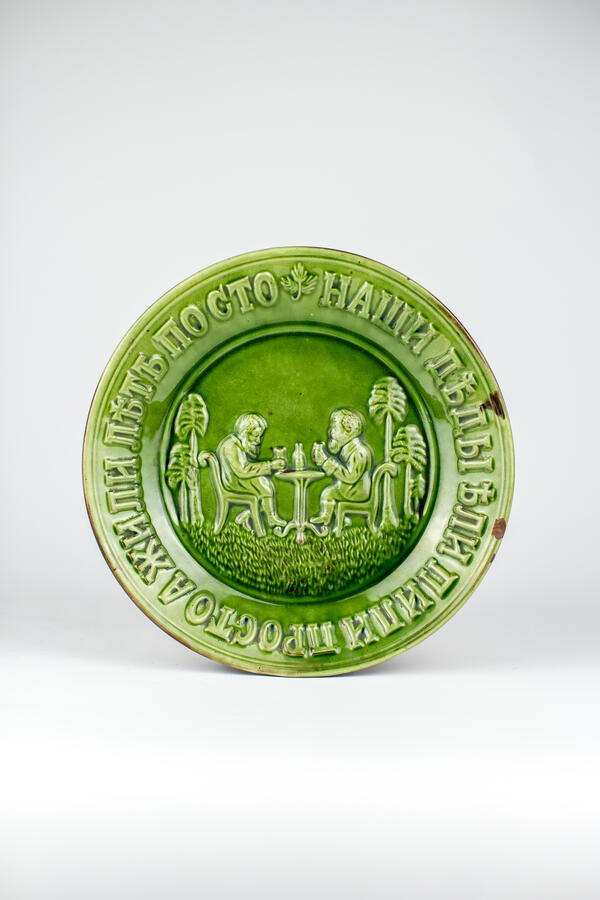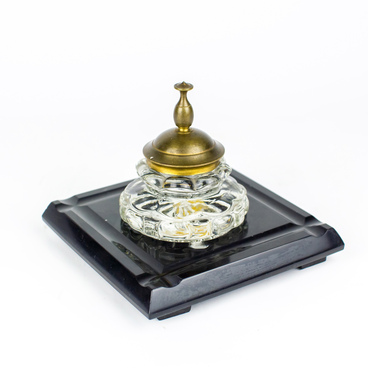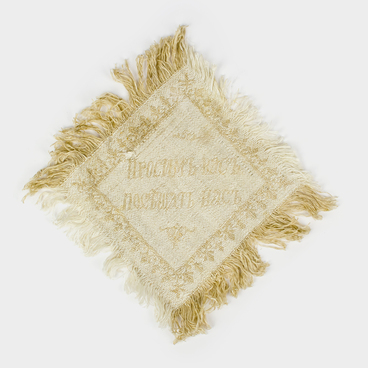The decorative plate with a Russian proverb along its side: “Our grandfathers ate and drank simple things, but lived for a hundred years” was made in the second half of the 19th century. It is covered with green glaze. At the bottom of the plate between the trees on the grass at the table are two men with glasses in their hands. There is no factory mark on the plate, but researchers suggest that the plate was created at the private factory of Mikhail Zaitsevsky.
The proverb inscribed on the plate refers to the traditional Russian cuisine. The key feature of the Russian table was bread, mainly rye, sometimes with an admixture of barley flour. Prosphoras, kalaches, holiday pies were baked from wheat flour. Kalaches were considered a delicacy, which has been preserved in the proverb “you can’t lure anyone with a kalach.”
Salt was not added to the bread, and the flour for it was not necessarily fresh. In “Domostroy” (a 16th century Russian household code), for example, zealous owners were advised to eat stale flour and lend the same out.
In the 16th and 17th centuries, oatmeal was often used, which was a mixture of oat or barley flour, to which it was enough to add water to get a sticky porridge. People often took it with them as a dry ration when travelling. The oatmeal, mixed with chilled boiled water, seasoned with salt, was called “kulaga”. It was a favorite treat for children.
Pies (pirogi) were another iconic dish of the Russian cuisine. They were divided into two categories: deep-fried and baked on the hearth. Until the 16th century, in Russia food was not fried, but deep-fried, that is, fried in a large amount of oil. A hearth pirog was the one that was baked on the hearth, that is, in the lower part of the oven.
In 1900-1913, one peasant in European Russia ate on average 692 grams of bread, 399 grams of potatoes, 73 grams of meat and fish, 377 grams of dairy products and 11 grams of sugar per day. On the table, there were usually many different dishes at the same time, but the diet depended on the church calendar. For example, on the days of fasting, it was forbidden to eat meat and dairy products.
Products were divided into “postny” (allowed when fasting) and “skoromny” (forbidden when fasting) foods. The simplest and cheapest meatless dish was tyurya, cold salted water with slices of bread and onions. Another famous meatless soup was polevka, soup made from fermented rye dough called “raschina”. The word “raschina”comes from the phrase “to leaven (or to make) kvashnya” — sour dough for making bread.
The proverb inscribed on the plate refers to the traditional Russian cuisine. The key feature of the Russian table was bread, mainly rye, sometimes with an admixture of barley flour. Prosphoras, kalaches, holiday pies were baked from wheat flour. Kalaches were considered a delicacy, which has been preserved in the proverb “you can’t lure anyone with a kalach.”
Salt was not added to the bread, and the flour for it was not necessarily fresh. In “Domostroy” (a 16th century Russian household code), for example, zealous owners were advised to eat stale flour and lend the same out.
In the 16th and 17th centuries, oatmeal was often used, which was a mixture of oat or barley flour, to which it was enough to add water to get a sticky porridge. People often took it with them as a dry ration when travelling. The oatmeal, mixed with chilled boiled water, seasoned with salt, was called “kulaga”. It was a favorite treat for children.
Pies (pirogi) were another iconic dish of the Russian cuisine. They were divided into two categories: deep-fried and baked on the hearth. Until the 16th century, in Russia food was not fried, but deep-fried, that is, fried in a large amount of oil. A hearth pirog was the one that was baked on the hearth, that is, in the lower part of the oven.
In 1900-1913, one peasant in European Russia ate on average 692 grams of bread, 399 grams of potatoes, 73 grams of meat and fish, 377 grams of dairy products and 11 grams of sugar per day. On the table, there were usually many different dishes at the same time, but the diet depended on the church calendar. For example, on the days of fasting, it was forbidden to eat meat and dairy products.
Products were divided into “postny” (allowed when fasting) and “skoromny” (forbidden when fasting) foods. The simplest and cheapest meatless dish was tyurya, cold salted water with slices of bread and onions. Another famous meatless soup was polevka, soup made from fermented rye dough called “raschina”. The word “raschina”comes from the phrase “to leaven (or to make) kvashnya” — sour dough for making bread.



